
POTTERY.
CINCINNATI COLLECTION.
UNITED STATES.
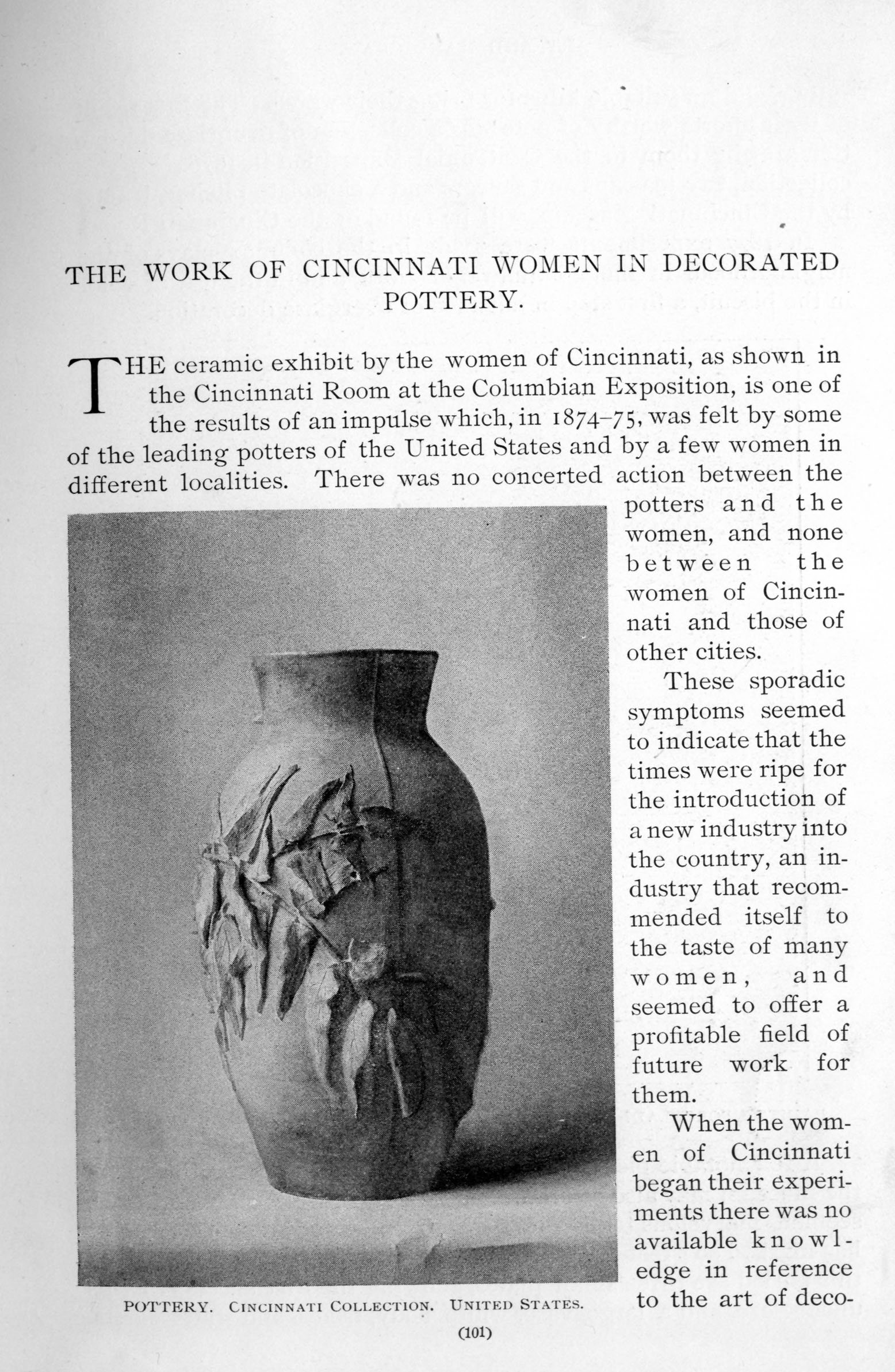
POTTERY.
CINCINNATI COLLECTION.
UNITED STATES.
THE WORK OF CINCINNATI WOMEN IN DECORATED POTTERY.
THE ceramic exhibit by the women of Cincinnati, as shown in the Cincinnati Room at the Columbian Exposition, is one of the results of an impulse which, in 1874-75, was felt by some of the leading potters of the United States and by a few women in different localities. There was no concerted action between the potters and the women, and none between the women of Cincinnati and those of other cities.
These sporadic symptoms seemed to indicate that the times were ripe for the introduction of a new industry into the country, an industry that recommended itself to the taste of many women, and seemed to offer a profitable field of future work for them.
When the women of Cincinnati began their experiments there was no available knowledge in reference to the art of deco-
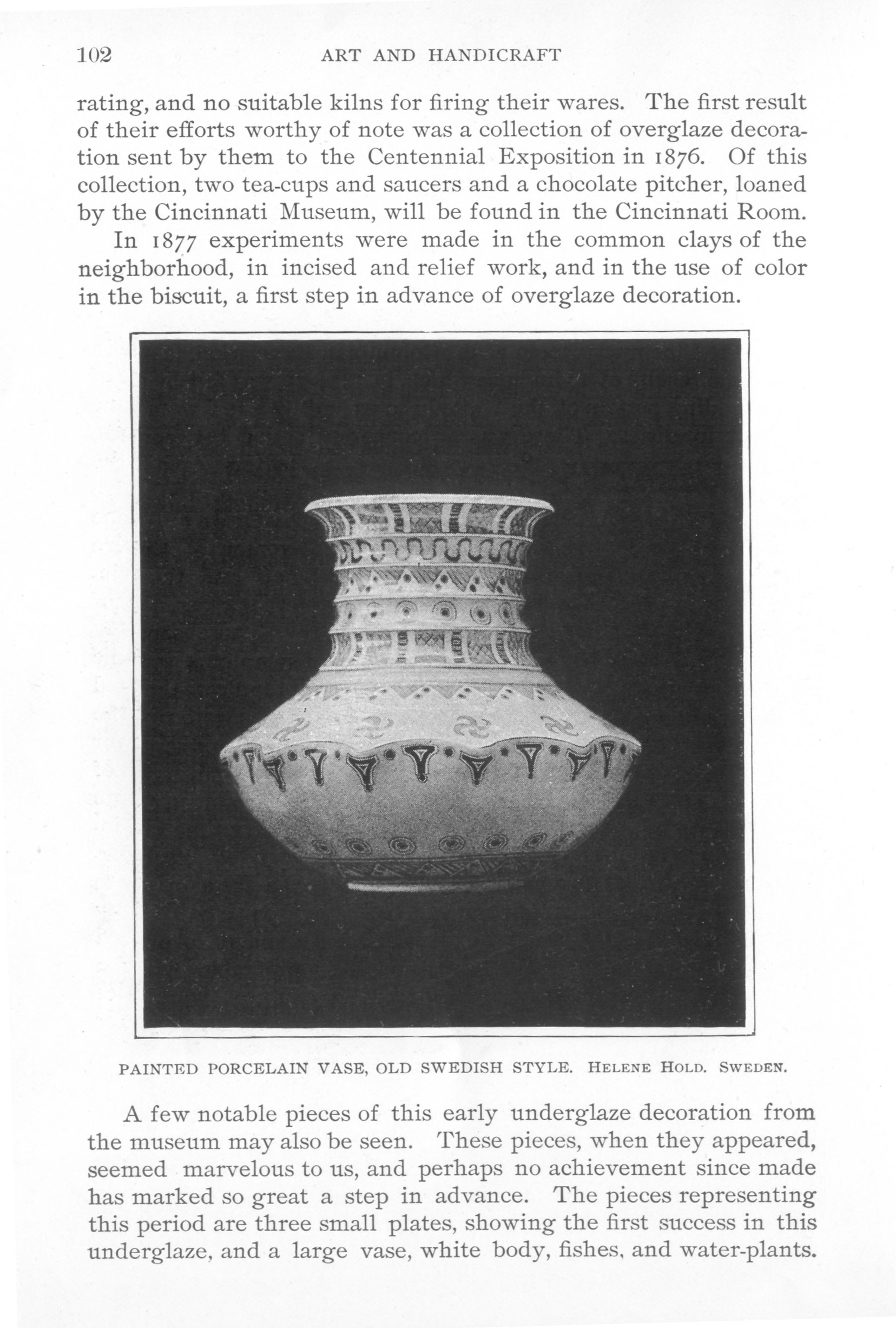
PAINTED PORCELAIN VASE,
OLD SWEDISH STYLE.
HELENE HOLD.
SWEDEN.
rating, and no suitable kilns for firing their wares. The first result of their efforts worthy of note was a collection of overglaze decoration sent by them to the Centennial Exposition in 1876. Of this collection, two tea-cups and saucers and a chocolate pitcher, loaned by the Cincinnati Museum, will be found in the Cincinnati Room.
In 1877 experiments were made in the common clays of the neighborhood, in incised and relief work, and in the use of color in the biscuit, a first step in advance of overglaze decoration.
A few notable pieces of this early underglaze decoration from the museum may also be seen. These pieces, when they appeared, seemed marvelous to us, and perhaps no achievement since made has marked so great a step in advance. The pieces representing this period are three small plates, showing the first success in this underglaze, and a large vase, white body, fishes, and water-plants.
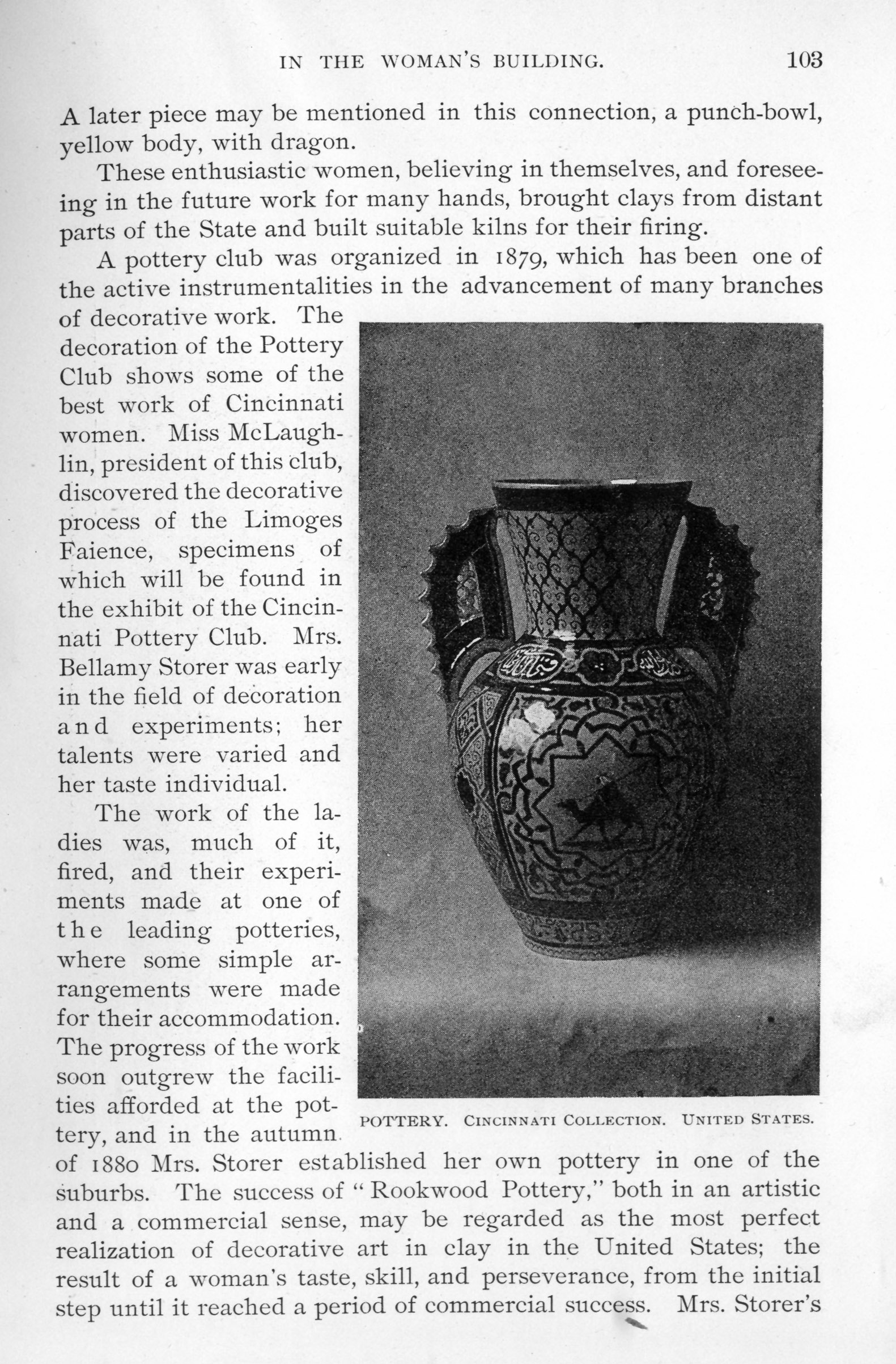
POTTERY.
CINCINNATI COLLECTION.
UNITED STATES.
A later piece may be mentioned in this connection, a punch-bowl, yellow body, with dragon.
These enthusiastic women, believing in themselves, and foreseeing in the future work for many hands, brought clays from distant parts of the State and built suitable kilns for their firing.
A pottery club was organized in 1879, which has been one of the active instrumentalities in the advancement of many branches of decorative work. The decoration of the Pottery Club shows some of the best work of Cincinnati women. Miss McLaughlin, president of this club, discovered the decorative process of the Limoges Faience, specimens of which will be found in the exhibit of the Cincinnati Pottery Club. Mrs. Bellamy Storer was early in the field of decoration and experiments; her talents were varied and her taste individual.
The work of the ladies was, much of it, fired, and their experiments made at one of the leading potteries, where some simple arrangements were made for their accommodation. The progress of the work soon outgrew the facilities afforded at the pottery, and in the autumn of 1880 Mrs. Storer established her own pottery in one of the suburbs. The success of "Rookwood Pottery," both in an artistic and a commercial sense, may be regarded as the most perfect realization of decorative art in clay in the United States; the result of a woman's taste, skill, and perseverance, from the initial step until it reached a period of commercial success. Mrs. Storer's
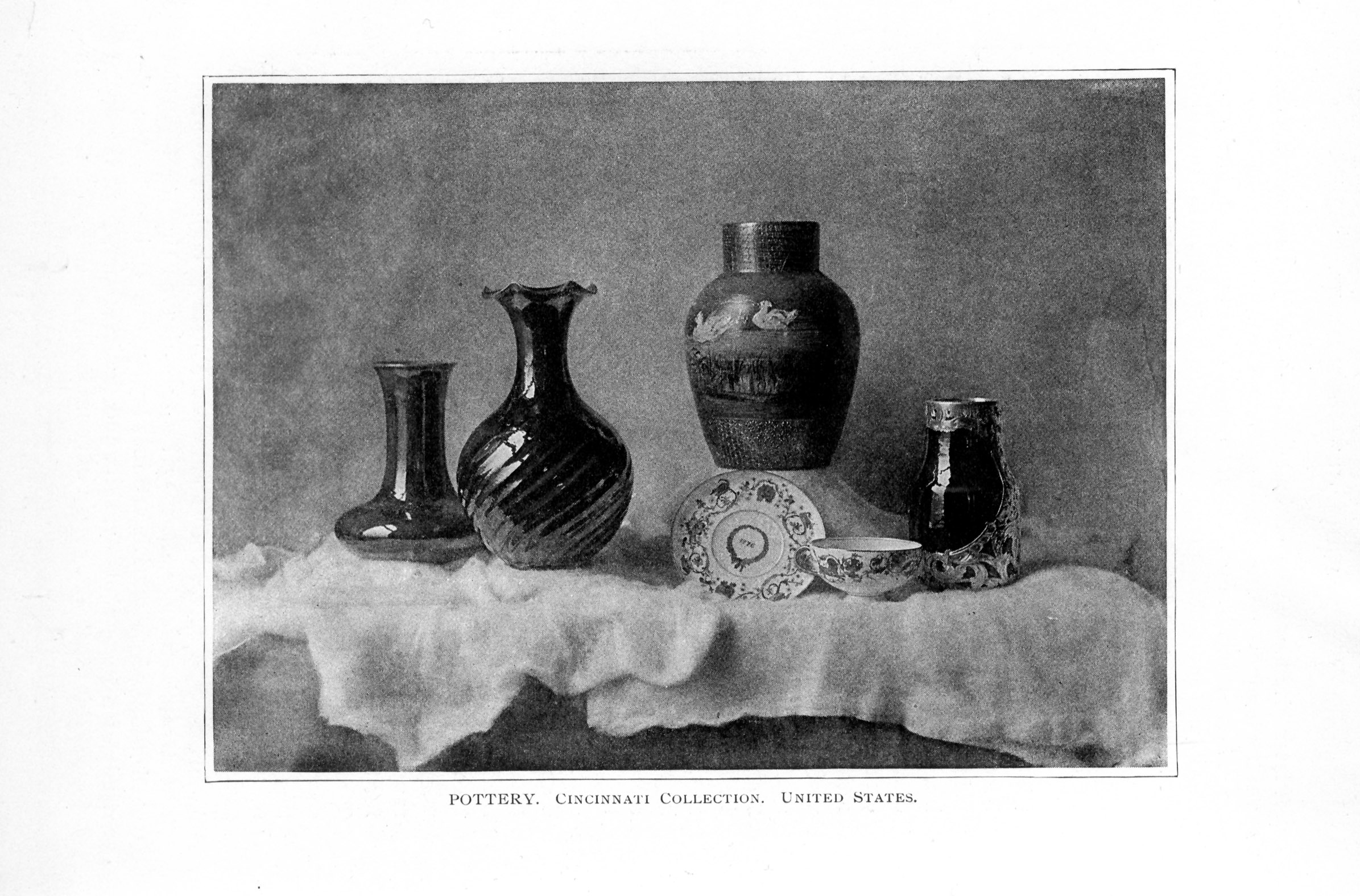
POTTERY.
CINCINNATI COLLECTION.
UNITED STATES.

POTTERY AND GLASS—
CINCINNATI COLLECTION.
UNITED STATES.
judgment led her to select those whose experience was greater than her own in perfecting her manufacture. The decorators, from the first, were pupils of the School of Design, and perhaps in the application of artistic principles to an industry the influence of the school has been as noticeably shown here as in any other direction.
Mrs. Storer herself, at intervals of leisure from her many engagements, continues to practice her favorite art of decoration, and her work will be shown in the Cincinnati Room. Her taste is inclined to the grotesque, and especially to the Japanese in style. She is reported to have said: "If any one thinks my dragons are not anatomically correct, let him prove it."
While Mrs. Storer was developing and perfecting her pottery, the Pottery Club, and many women outside of it, were as busily engaged in the various branches of potting and porcelain decoration.
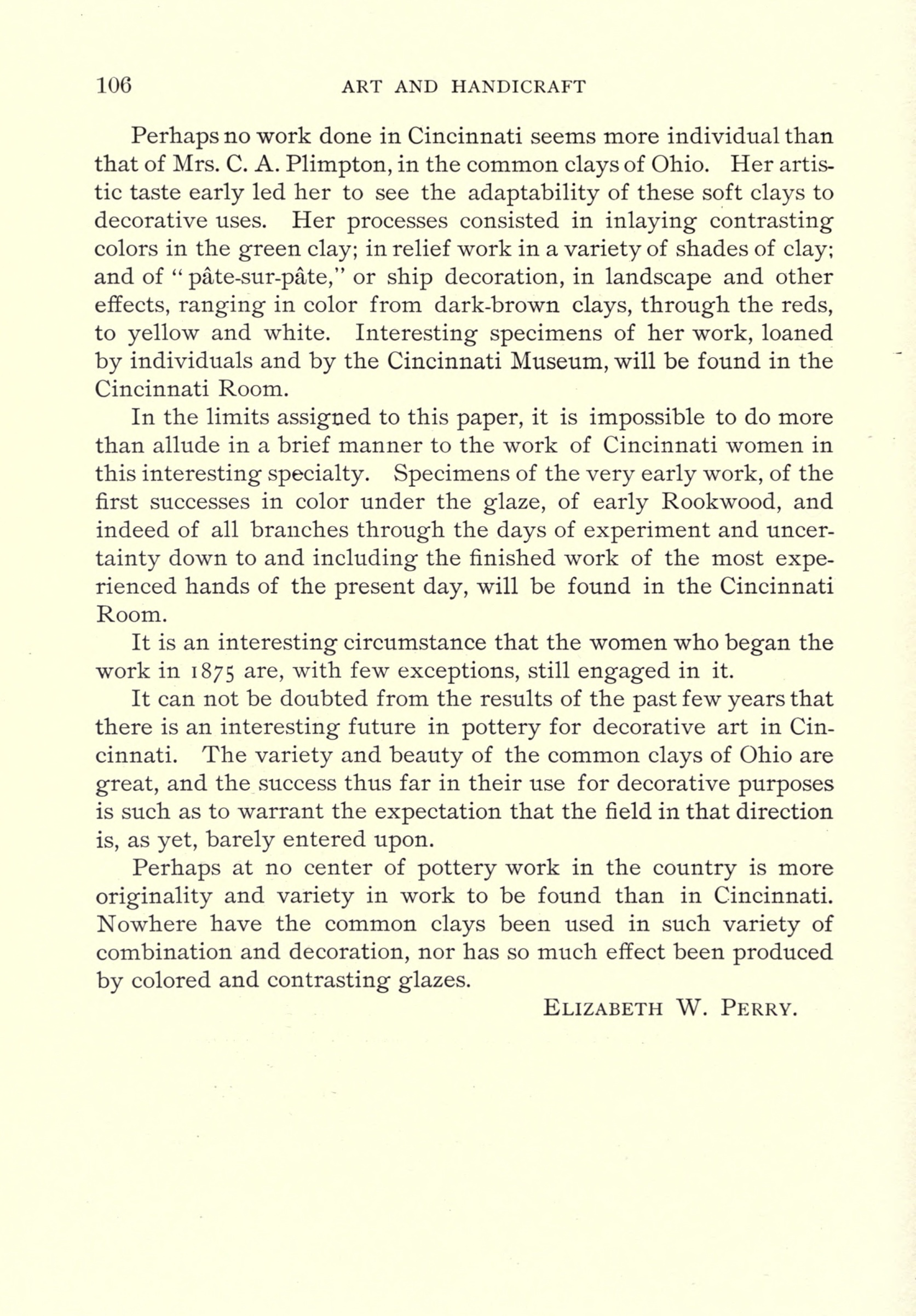
Perhaps no work done in Cincinnati seems more individual than that of Mrs. C. A. Plimpton, in the common clays of Ohio. Her artistic taste early led her to see the adaptability of these soft clays to decorative uses. Her processes consisted in inlaying contrasting colors in the green clay; in relief work in a variety of shades of clay; and of "pâte-sur-pâte," or ship decoration, in landscape and other effects, ranging in color from dark-brown clays, through the reds, to yellow and white. Interesting specimens of her work, loaned by individuals and by the Cincinnati Museum, will be found in the Cincinnati Room.
In the limits assigned to this paper, it is impossible to do more than allude in a brief manner to the work of Cincinnati women in this interesting specialty. Specimens of the very early work, of the first successes in color under the glaze, of early Rookwood, and indeed of all branches through the days of experiment and uncertainty down to and including the finished work of the most experienced hands of the present day, will be found in the Cincinnati Room.
It is an interesting circumstance that the women who began the work in 1875 are, with few exceptions, still engaged in it.
It can not be doubted from the results of the past few years that there is an interesting future in pottery for decorative art in Cincinnati. The variety and beauty of the common clays of Ohio are great, and the success thus far in their use for decorative purposes is such as to warrant the expectation that the field in that direction is, as yet, barely entered upon.
Perhaps at no center of pottery work in the country is more originality and variety in work to be found than in Cincinnati. Nowhere have the common clays been used in such variety of combination and decoration, nor has so much effect been produced by colored and contrasting glazes.
ELIZABETH W. PERRY.